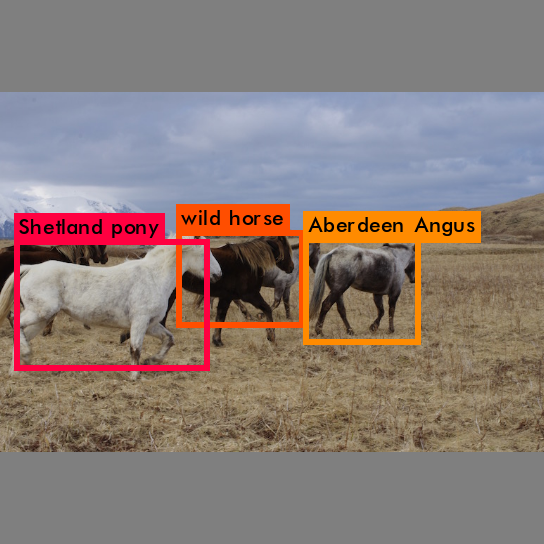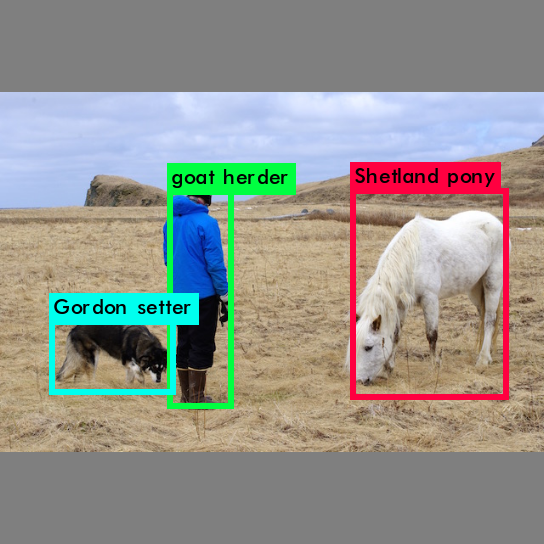philipperemy / Yolo 9000
Projects that are alternatives of or similar to Yolo 9000
Yolo 9000
YOLO9000: Better, Faster, Stronger - Real-Time Object Detection (State of the art). Official repository of CVPR17.

Scroll down if you want to make your own video.
How to get started?
Ubuntu/Linux/Mac OS
git clone --recursive https://github.com/philipperemy/yolo-9000.git
cd yolo-9000
cat yolo9000-weights/x* > yolo9000-weights/yolo9000.weights # it was generated from split -b 95m yolo9000.weights
cd darknet
make # Will run on CPU. For GPU support, scroll down!
./darknet detector test cfg/combine9k.data cfg/yolo9000.cfg ../yolo9000-weights/yolo9000.weights data/horses.jpg
Windows
git clone --recursive https://github.com/philipperemy/yolo-9000.git
cd yolo-9000
type yolo9000-weights\xaa yolo9000-weights\xab > yolo9000-weights\yolo9000.weights
certUtil -hashfile yolo9000-weights\yolo9000.weights MD5
cd darknet
git reset --hard b61bcf544e8dbcbd2e978ca6a716fa96b37df767
You can use the latest version of darknet by running this command in the directory yolo-9000:
git submodule foreach git pull origin master
The output should be something like:
layer filters size input output
0 conv 32 3 x 3 / 1 544 x 544 x 3 -> 544 x 544 x 32
1 max 2 x 2 / 2 544 x 544 x 32 -> 272 x 272 x 32
2 conv 64 3 x 3 / 1 272 x 272 x 32 -> 272 x 272 x 64
3 max 2 x 2 / 2 272 x 272 x 64 -> 136 x 136 x 64
4 conv 128 3 x 3 / 1 136 x 136 x 64 -> 136 x 136 x 128
5 conv 64 1 x 1 / 1 136 x 136 x 128 -> 136 x 136 x 64
6 conv 128 3 x 3 / 1 136 x 136 x 64 -> 136 x 136 x 128
7 max 2 x 2 / 2 136 x 136 x 128 -> 68 x 68 x 128
8 conv 256 3 x 3 / 1 68 x 68 x 128 -> 68 x 68 x 256
9 conv 128 1 x 1 / 1 68 x 68 x 256 -> 68 x 68 x 128
10 conv 256 3 x 3 / 1 68 x 68 x 128 -> 68 x 68 x 256
11 max 2 x 2 / 2 68 x 68 x 256 -> 34 x 34 x 256
12 conv 512 3 x 3 / 1 34 x 34 x 256 -> 34 x 34 x 512
13 conv 256 1 x 1 / 1 34 x 34 x 512 -> 34 x 34 x 256
14 conv 512 3 x 3 / 1 34 x 34 x 256 -> 34 x 34 x 512
15 conv 256 1 x 1 / 1 34 x 34 x 512 -> 34 x 34 x 256
16 conv 512 3 x 3 / 1 34 x 34 x 256 -> 34 x 34 x 512
17 max 2 x 2 / 2 34 x 34 x 512 -> 17 x 17 x 512
18 conv 1024 3 x 3 / 1 17 x 17 x 512 -> 17 x 17 x1024
19 conv 512 1 x 1 / 1 17 x 17 x1024 -> 17 x 17 x 512
20 conv 1024 3 x 3 / 1 17 x 17 x 512 -> 17 x 17 x1024
21 conv 512 1 x 1 / 1 17 x 17 x1024 -> 17 x 17 x 512
22 conv 1024 3 x 3 / 1 17 x 17 x 512 -> 17 x 17 x1024
23 conv 28269 1 x 1 / 1 17 x 17 x1024 -> 17 x 17 x28269
24 detection
Loading weights from ../yolo9000-weights/yolo9000.weights...Done!
data/horses.jpg: Predicted in 7.556429 seconds.
wild horse: 50%
Shetland pony: 84%
Aberdeen Angus: 72%
Not compiled with OpenCV, saving to predictions.png instead
The image with the bounding boxes is in predictions.png.
Names of the 9k classes
Available here:
Examples
./darknet detector test cfg/combine9k.data cfg/yolo9000.cfg ../yolo9000-weights/yolo9000.weights data/horses.jpg
./darknet detector test cfg/combine9k.data cfg/yolo9000.cfg ../yolo9000-weights/yolo9000.weights data/person.jpg
Browse on https://pjreddie.com/darknet/yolo/ to find how to compile it for GPU as well. It's much faster!
GPU Support
Make sure that your NVIDIA GPU is properly configured beforehand. nvcc should be in the PATH. If not, something like this should do the job:
export PATH=/usr/local/cuda/bin:$PATH
export LD_LIBRARY_PATH=/usr/local/cuda/lib64:$LD_LIBRARY_PATH
Let's now compile darknet with GPU support!
cd darknet
make clean
vim Makefile # Change the first two lines to: GPU=1 and CUDNN=1. You can also use emacs or nano!
make
./darknet detector test cfg/combine9k.data cfg/yolo9000.cfg ../yolo9000-weights/yolo9000.weights data/dog.jpg
The inference should be much faster:
Loading weights from ../yolo9000-weights/yolo9000.weights...Done!
data/dog.jpg: Predicted in 0.035112 seconds.
car: 70%
canine: 56%
bicycle: 57%
Not compiled with OpenCV, saving to predictions.png instead
You can also run the command and monitor its status with nvidia-smi:
+-----------------------------------------------------------------------------+
| NVIDIA-SMI 375.26 Driver Version: 375.26 |
|-------------------------------+----------------------+----------------------+
| GPU Name Persistence-M| Bus-Id Disp.A | Volatile Uncorr. ECC |
| Fan Temp Perf Pwr:Usage/Cap| Memory-Usage | GPU-Util Compute M. |
|===============================+======================+======================|
| 0 TITAN X (Pascal) Off | 0000:02:00.0 On | N/A |
| 26% 49C P2 76W / 250W | 4206MiB / 12189MiB | 10% Default |
+-------------------------------+----------------------+----------------------+
| 1 TITAN X (Pascal) Off | 0000:04:00.0 Off | N/A |
| 29% 50C P8 20W / 250W | 3MiB / 12189MiB | 0% Default |
+-------------------------------+----------------------+----------------------+
| 2 TITAN X (Pascal) Off | 0000:05:00.0 Off | N/A |
| 31% 53C P8 18W / 250W | 3MiB / 12189MiB | 0% Default |
+-------------------------------+----------------------+----------------------+
| 3 TITAN X (Pascal) Off | 0000:06:00.0 Off | N/A |
| 29% 50C P8 22W / 250W | 3MiB / 12189MiB | 0% Default |
+-------------------------------+----------------------+----------------------+
+-----------------------------------------------------------------------------+
| Processes: GPU Memory |
| GPU PID Type Process name Usage |
|=============================================================================|
| 0 30782 C ./darknet 3991MiB |
+-----------------------------------------------------------------------------+
Here, we can see that our process darknet is running on the first GPU.
NOTE: We highly recommend a recent GPU with 8GB (or more) of memory to run flawlessly. GTX 1070, GTX 1080 Ti or Titan X are a great choice!
Make your own video! (Ubuntu/Linux)
First we have to install some dependencies (OpenCV and ffmpeg):
sudo apt-get install libopencv-dev python-opencv ffmpeg
cd darknet
make clean
vim Makefile # Change the first three lines to: GPU=1, CUDNN=1 and OPENCV=1. You can also use emacs or nano!
make
./darknet detector demo cfg/combine9k.data cfg/yolo9000.cfg ../yolo9000-weights/yolo9000.weights -prefix output <path_to_your_video_mp4> -thresh 0.15
By default the threshold is set to 0.25. It means that Yolo displays the bounding boxes of elements with a 25%+ confidence. In practice, a lower threshold means more detected items (but also more errors).
Once this command returns, we merge the output images in a video:
ffmpeg -framerate 25 -i output_%08d.jpg output.mp4
We can now safely remove the temporary generated images:
rm output_*.jpg
The final video is output.mp4.
Convert the weights to Keras
Comment the following lines in the yolo9000.cfg file:
batch=1
subdivisions=1
Then browse the instructions at:


